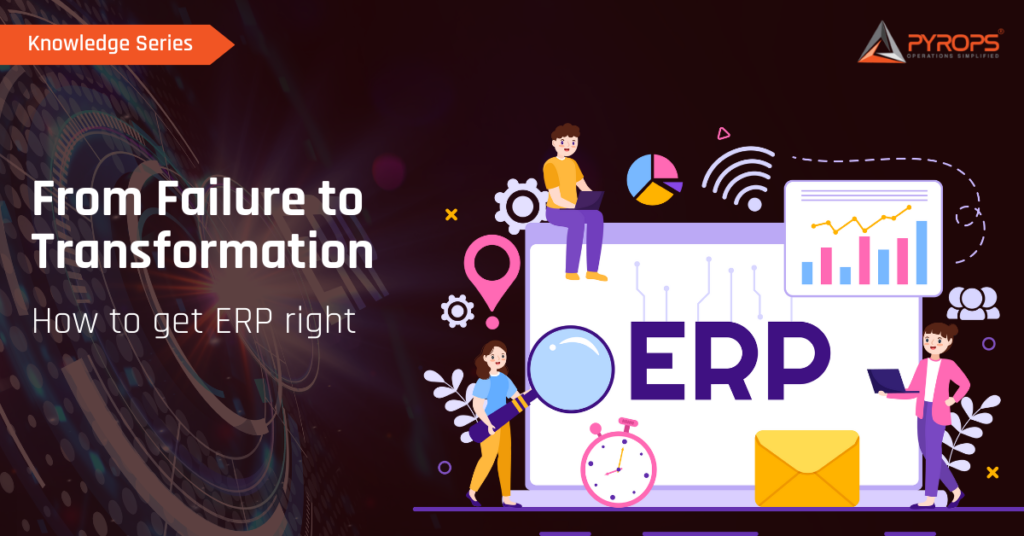Home > Knowledge Series > Why do most ERP implementations fail?

From Failure to Transformation How to get ERP right
Why do most ERP implementations fail?
ERP has the power to transform how a business runs. Yet studies show 50–60% of ERP projects underperform or fail outright. The reasons are rarely “bad software” — more often it’s how businesses approach the journey.
Let’s unpack the common pitfalls with real-world flavors, and how to overcome them.
1. Unclear Objectives & Misaligned Expectations
- Pitfall: Businesses implement ERP as a “tech upgrade” without defining business outcomes.
- Example: A manufacturing company rolls out ERP to “replace spreadsheets” but doesn’t define clear KPIs (like reducing order-to-cash cycle time). Result: system goes live, but inefficiencies remain.
- How to avoid: Begin with business-first goals (e.g., 20% faster month-end closing, real-time inventory visibility). Anchor every project milestone to these goals.
2. Poor Change Management & User Resistance
- Pitfall: Employees resist because ERP feels like a burden. Training is last-minute or ignored.
- Example: A retail chain implements ERP but cashiers and warehouse staff keep using old manual logs because they weren’t trained properly — data stays fragmented.
- How to avoid: Involve users from Day 1. Run change workshops, gamify training, and appoint “ERP champions” within each department to ease adoption.
3. Over-Customization of the System
- Pitfall: Companies try to replicate every legacy process in the ERP, coding endless custom modules. This makes upgrades painful and costly.
- Example: A distribution firm adds 15 custom workflows for order approvals, only to find upgrades require rewriting all custom code — stalling for months.
- How to avoid: Follow the “80/20 Rule” — stick to standard ERP best practices for 80% of processes, customize only for truly differentiating business needs.
4. Weak Data Discipline & Dirty Migration
- Pitfall: “Garbage in, garbage out.” Legacy data is often full of duplicates, mismatched formats, and outdated records.
- Example: A pharma company migrates supplier master data with 3 versions of the same vendor — leading to payment errors and compliance risks.
- How to avoid: Invest in data governance before migration. Deduplicate, validate, and standardize. Assign ownership of master data quality to specific teams.
Make your ERP a success—integrate it with a WMS to streamline operations and boost efficiency.
5. Underestimating Time, Cost, and Resources
- Pitfall: Leaders assume ERP is “just another IT project,” and don’t budget for process reengineering or training.
- Example: A mid-sized bank planned a 6-month rollout. With regulatory and process complexities, it took 18 months and double the budget.
- How to avoid: Treat ERP as a business transformation, not IT. Build a realistic phased roadmap with time for testing, feedback, and process redesign.
How to Avoid These Pitfalls:
- Start with a clear transformation roadmap (not just an IT upgrade).
- Engage business leaders & end-users early — ERP is for people, not just processes.
- Keep customization minimal — adapt business where possible to standard ERP best practices.
- Invest in data cleanup and governance before migration.
Treat ERP as a journey — start with core processes, then evolve.
Some frameworks for Ensuring ERP Success
Here are some basic but powerful frameworks you can embed into your ERP journey:
- The 3P Framework: People – Process – Platform
- People: Engage leadership, train users, appoint change champions.
- Process: Redesign workflows to match best practices, not just old habits.
- Platform: Configure ERP around clear business needs with minimal customization.
- The “ERP Success Triangle”
ERP projects succeed when there’s a balance between:
- Strategic Alignment (clear goals + executive sponsorship)
- Operational Discipline (process mapping, data governance, testing)
- Change Management (training, adoption, feedback loops)
- Phased Implementation Roadmap
- Phase 1: Core financials & compliance (foundation).
- Phase 2: Operations modules (inventory, supply chain, HR).
- Phase 3: Advanced analytics, AI-driven insights, integrations.
This reduces risk, shows quick wins, and builds momentum.
Conclusion
ERP failure is rarely about software. It’s about vision, execution, and adoption. With clear goals, disciplined processes, and people-first change management, ERP can become the nervous system that powers growth.
- Start with a clear transformation roadmap (not just an IT upgrade).
- Engage business leaders & end-users early — ERP is for people, not just processes.
- Keep customization minimal — adapt business where possible to standard ERP best practices.
- Invest in data cleanup and governance before migration.
Treat ERP as a journey — start with core processes, then evolve.
4. Weak Data Discipline & Dirty Migration

|
|
Thank you for Signing Up |









